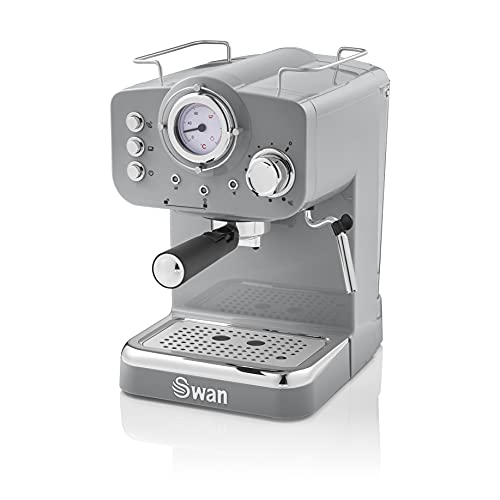Coffee and Espresso Machines
Espresso machines make use of pressure to push water through finely ground and tamped coffee beans. They create a rich and flavorful brew.
Good Housekeeping Institute experts recommend models that are brewed at a minimum of 9 bars to ensure the best extraction. Beware of brands that advertise more pressure than is necessary.
Types
The espresso maker (also known as a coffee or Espresso maker) produces coffee that is more concentrated, of higher quality, and is more expensive than your favorite cafe drinks. It utilizes an average of nine bars of pressure. They come with a range of features, such as temperature and brew-strength control with programmable brewing as well as multiple sizes of drinks. Certain machines might come with steam wands with either manual or automatic settings for creating texturized milk for latte art. There are three main types that are semi-automatic; super-automatic; and automated. Each espresso machine comes with its own level and type of automation.
Semi-automatic espresso machines are the most popular choice for specialty coffee shops. This allows baristas to have full control over the brewing process however it's not as user-friendly as an automated or fully automated machine. To get the most perfect espresso shot, you must grind the beans, then fill the portafilter and tamp it down, and alter the extraction time.
Automatic machines come with built-in mills and can measure and grind your grounds. They automatically disperse the proper amount of water required to extract the espresso, and often have a programmable beverage size function. In our laboratory tests, they were the most favored kind of espresso machine. They offer a great combination of control and consistency.
Functions
You'll need a reservoir hold the water that you use to make coffee, irrespective of whether you opt for a steam-driven or pump-driven machine. You'll also have heating elements that heat the cold water in order to create the powerful pressure required to extract coffee from ground.
When the button to brew is hit to brew, the water inlet valve is closed to ensure that only hot water with intense pressure can flow through the portafilter and into the ground coffee. The water takes approximately 25 seconds to turn into espresso.

best budget espresso machine insulated tubing called the hot-water tube is affixed from the reservoir to the spout on top of your machine. The resistance heating element heats the water as the water passes through the aluminum tube and metal warming plate.
After the spout has turned on the cup, place it under the spout to ensure that espresso flows into the cup through the portafilter. The coffee maker is also likely to have a steam wand which you can use to heat and froth the milk for espresso-based drinks such as cappuccino or lattes.
Automatic machines eliminate the guesswork from making coffee. They have a one-button operation they can be programmed and grind and measure beans for you, and grind them down. In our Lab tests, they tend to perform the best because they're easy to use and do not require any special skills from the user.
Materials
The inside of an espresso machine is a veritable world of copper tubes, boilers made of stainless steel, as well as sophisticated firmware. While they may appear complicated the primary purpose of these machines is to convert hot water into finely ground coffee.
When buying an espresso maker it is important to consider the size and space requirements as along with drink options, energy saving options, and brewing accuracy. Also look for a knob that can activate the steam wand for frothing milk and creating Latte art. The front of the machine includes an indicator of pressure that will show the operating pressure of the boiler and pump. Find a coffee maker that has two needles, so that you can both the maximum and minimum pressure.
If you are looking for more than espresso, then you should consider an espresso machine that comes with various brew sizes. This includes the ristretto. There are models that have an adjustable frothing hopper which allows for hassle-free, hands-free frothing. You can also switch between different types milk easily. Select a model with an integrated softener if you have hard water in order to prevent mineral accumulation and to keep your espresso fresh.
Certain manufacturers employ PID (proportional, integral, digital) thermostat to maintain the temperature of espresso brewing. This feature allows for the same high-quality, consistent cup of espresso each time. It also saves on energy costs, since the machine only operates only when it is needed.
Maintenance
The maintenance of espresso and coffee machines is becoming more important as they become more available for home use. The best equipment can make a huge difference in the quality of your coffee, but only if it's well maintained.
A regular maintenance and cleaning routine should include everything from cleaning the group head and steam wand, to descaling, to changing the water filter frequently. As a rule of thumb when you're making between two and five cups of coffee a day, you should wash the majority of the machine every week. However, some parts of the machine, such as the grinder and water tank must be cleaned every two or three weeks.
Additionally, you should backflush your machine on a weekly basis. This process involves locking the portafilter in position and running the brew cycle several times. This will help remove any coffee grounds or oils that have been left behind. You can also use a brush and cleaner designed specifically for espresso machines to clean the portafilter.
Maintaining your coffee and espresso machine correctly will also make it last longer. It is important to take care of your expensive professional espresso machine.
